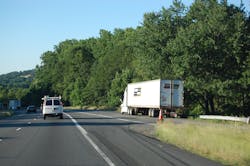Rob Abbott will tell you that if you look at long-term motor carrier safety trends over the last 30 years, you’ll note that there’s been a steep decline in the crash rate for large trucks. But if you narrow that focus to the last decade or so, you’ll note that the decline hasn’t been as steep.
He told Fleet Owner the reason for this “leveling off” is simple: much of the “low hanging fruit” in terms of safety improvements, especially when it comes to vehicle technology, has already been picked.
“We’ve already gone after the low-hanging fruit such as better braking systems, limiting speed, better stability control, and advanced driver screening,” explained Abbott, who now heads up the commercial trucking team at Lytx after serving as vice president for safety policy for the American Trucking Associations (ATA) trade group.
“Fleets now have to work even harder to find the next safety revolution tool,” he noted.
As an illustration of this “safety leveling” trend can be found in the Large Truck and Bus Crash Facts 2014 report issued by the Federal Motor Carrier Safety Administration (FMCSA) back in April.
Take just fatal crashes involving large truck and buses by themselves: from 1979 to 2009, total fatal crashes dropped from 6,007 to 3,193 – a decline of 46% or some 2,814 fatal crashes. But from 2009 to 2014 – not quite a decade – fatal crashes increased from 3,193 to 3,649; an increase of 456 crashes or 12%.
If you look at the large crash rate per 100 million vehicle miles traveled (VMT) a similar “leveling off” occurs as well. From 1979 to 2009, the rate dropped from 5.6 all the way down to 1.1, FMCSA reported, but between 2009 and 2014, the rate inched up from 1.1 to 1.3.
Abbott believes that the “next step” needed in order to produce further improvements in crash rates will revolve around video systems, especially in terms of how they can improve the coaching of drivers.
“Video is important for two reasons: one is that it provides evidence to vindicate a truck driver’s story. And, two, it will help the industry coach drivers to do more of the right things,” he said. “Because driver behavior is the main factor in 87% of [truck] crash events. And we’re not talking just the truck driver here; we’re talking about other motorists, too. Truck drivers are frustrated by other motorist [behavior] and video can help vindicate their [truck driver] stories about [motorist] lane departures and sudden braking. Truck drivers are eager for that evidence.”
Such video evidence may also be the key to gaining what Abbott called a “truer picture” of the trucking industry’s safety performance as well.
“At ATA we used videos at Congressional hearings to show irresponsible motorists cutting off trucks and causing crashes – yet how those crashes still counted against a [motor] carrier’s CSA score,” he pointed out. “So as more video data becomes publicly available, that could become possible leverage for re-examining the industry’s safety picture.”
About the Author
Sean Kilcarr
Editor in Chief
Sean Kilcarr is a former longtime FleetOwner senior editor who wrote for the publication from 2000 to 2018. He served as editor-in-chief from 2017 to 2018.
